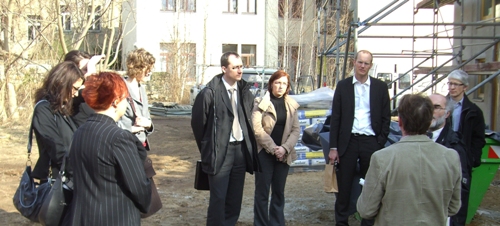Passive houses in Saxony, Germany
Saxony has identified a large CO2 reduction potential in the heat supply of buildings. The so-called passive houses consume around 15kWh/m²/year which is at least 3-5 times less than low energy houses and 7-20 times less than existing buildings. Saxony started its first pilot project "Innovation and Practice Network Passive Houses" as early as 2002. Since then the number of passive houses has increased significantly. Saxony financially supports builders and provides a lot of information including on-site visits.
This was the motivation for the study visit following the EnercitEE kick-off meeting when Working Group and Steering Group members could see and understand the quality requirements of building materials and quality checks being performed.

The tour through the construction site was guided by the architect, Guenther Rentzsch who explained the technical details and showed how waste heat from the discharged air will be used again in the passive house. He also pointed out the difficulties in testing if a building really meets the required standards. Mr. Rentzsch introduced the participants to a special pressure test for passive houses that is called the ‘blower-door’. This test makes any air leakages immediately visible.

It is carried out when interior fittings are complete (windows, facades, etc.). The craftsmen who should be involved in the building process have to be present during this test. This visual proof is accepted by all affected companies which will readjust certain details after this test.

Corresponding documents for download (PDF-files)
- Leaflet on "Passive houses in Saxony, Germany"
- Background material: Passive houses in Saxony
- Background material: Passive house construction
- Passive house example: "Nestwerk Pillnitz"
- Passive house example: "Kindergarten Heidenau"
- Passive house example: "Kindergarten Doebeln"
